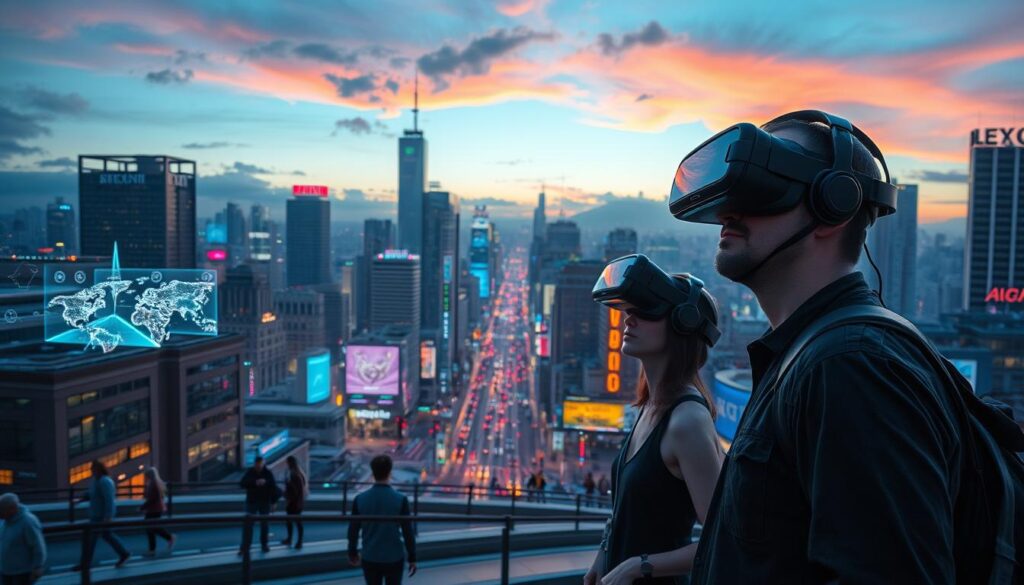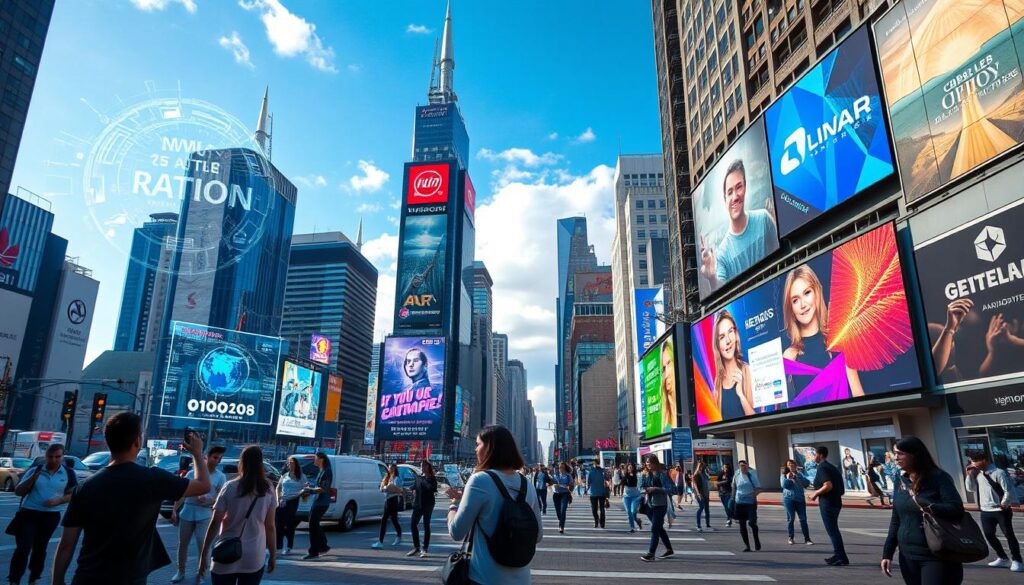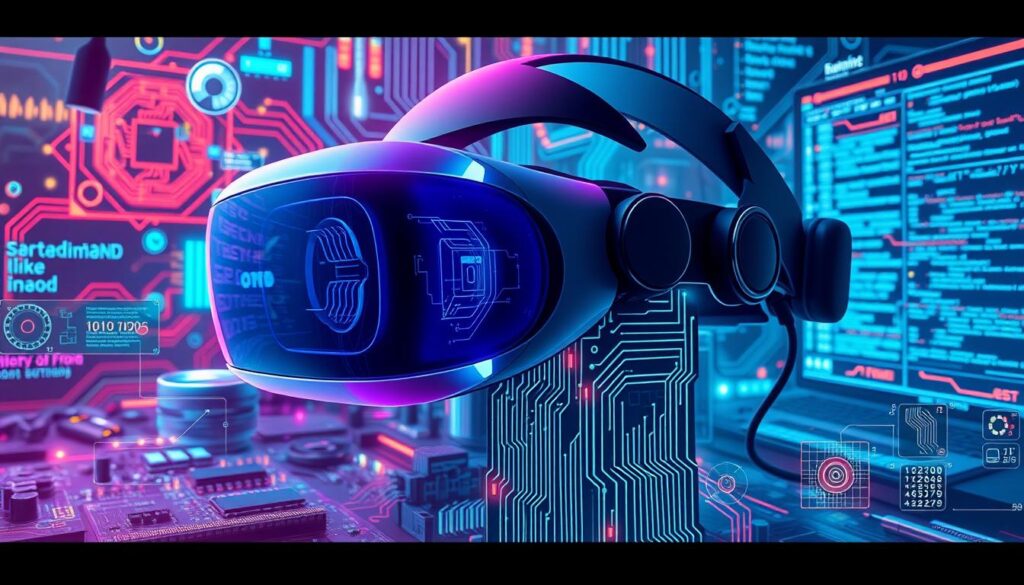Did you know the AR and VR market is set to hit a whopping $571 billion by 2025? This growth shows the huge impact these immersive technologies have on our world. AR adds digital info to our surroundings, while VR takes us into a fully simulated world. This changes how we engage with digital content. AR and VR are used in gaming, healthcare, education, and real estate, promising to revolutionize these fields and improve our daily lives.

In this guide, we’ll delve into the vast potential of AR and VR. They’re not just changing the game; they’re setting a new standard. Join us as we explore how these technologies are redefining digital interaction and transforming user experiences across various sectors.
Key Takeaways
- Augmented reality and virtual reality are rapidly growing technologies expected to reshape various industries.
- AR technology enhances reality by overlaying information on the physical world.
- VR experiences create immersive environments that transport users to entirely virtual realms.
- The projected market value of AR and VR indicates significant investment opportunities.
- Applications of these technologies span gaming, healthcare, education, and real estate.
Understanding Augmented Reality and Virtual Reality
Augmented reality (AR) and virtual reality (VR) are revolutionizing our digital interactions. They use advanced tech to create immersive experiences that alter or enhance our view of reality.
AR adds digital layers to the real world, using camera lenses and displays. It’s available on mobile devices and through AR apps. For instance, Pokémon GO and Snapchat filters let users see digital elements in their surroundings.
On the other hand, VR requires special gear like headsets to immerse users in a digital world. It blocks out the real world, offering detailed experiences mainly for gaming and training. Oculus Rift and HTC Vive are popular VR platforms, providing realistic and engaging environments.
AR software and VR headsets are crucial for these technologies. They enable digital elements to blend with reality and allow users to enter virtual spaces. The user interfaces are designed for seamless interaction, whether through touch in AR or motion tracking in VR. Grasping these components is essential for understanding the wide range of applications and future advancements in these immersive fields.
Key Differences Between AR and VR
In the world of immersive technologies, Augmented Reality (AR) and Virtual Reality (VR) stand out. Each offers a unique experience. AR overlays digital elements onto the real world, enabling users to interact with both physical and virtual components. On the other hand, VR creates a fully digital environment, cutting off the physical world.
Grasping the difference between AR and VR is crucial for organizations to choose the right technology. Their distinct characteristics are outlined below:
- Hardware Requirements: AR uses smartphones or tablets with cameras, whereas VR requires dedicated headsets like Oculus Quest or HTC Vive.
- User Interaction: AR allows users to interact in real-world settings, whereas VR confines users to a digital world.
- Applications: AR is widely used in retail, education, and maintenance. VR, however, excels in gaming, healthcare simulations, and professional training.
| Aspect | Augmented Reality (AR) | Virtual Reality (VR) |
|---|---|---|
| Experience Type | Digital content overlay on real-world | Complete immersion in a digital world |
| Hardware | Smartphones, tablets | Dedicated VR headsets |
| User Engagement | Interaction with both physical and digital elements | Interaction within a virtual environment only |
| Typical Uses | Retail, training, navigation | Gaming, simulations, virtual tours |
Immersive Technologies: The Future of Digital Interaction
The landscape of immersive technologies is rapidly evolving, setting the stage for the future of AR and VR. These advancements open up new possibilities for enhancing digital interactions across various sectors. As augmented reality and virtual reality continue to evolve, users are set to experience more engaging and interactive environments.
In corporate settings, the use of VR for training is on the rise. Companies are leveraging technology to create realistic simulations that improve learning experiences. Digital interaction advancements in this field allow trainees to practice in real-life scenarios without the risks. Educational institutions are also incorporating these technologies into their curricula, promoting immersive learning.
Mobile devices are increasingly featuring AR capabilities. This trend supports users in their daily tasks, offering richer, more interactive experiences. Retailers are using AR to boost customer engagement, allowing consumers to see products in their own space before buying.
The blending of AR and VR signals the potential of mixed reality applications. This blend will redefine user engagement, enabling seamless interaction within digital landscapes. As immersive technologies advance, they will undoubtedly shape future communication and collaboration methods. This highlights the crucial need to stay updated with emerging trends in this dynamic field.
Applications of Augmented Reality Technology
Augmented reality technology is transforming various industries, showcasing its versatility and impact. Innovators use AR to enhance processes and enrich user experiences. This section explores key areas where AR is making a significant difference.
Healthcare Innovations with AR
AR in healthcare is introducing groundbreaking innovations, enhancing patient care and medical training. Surgeons use AR technology during operations, overlaying critical information on the patient’s body. This improves precision and decision-making.
Medical students benefit from realistic simulations that mimic actual surgical procedures. These simulations help them understand complex concepts better.
AR in Retail: Enhancing Customer Experience
AR in retail is changing customer interactions, allowing shoppers to see products in real time. For instance, IKEA’s app lets users place furniture in their home environment using their smartphone camera. This ensures better purchasing decisions.
Retailers use augmented reality applications to create engaging experiences. These experiences elevate customer satisfaction and loyalty.
Education and Training Through AR
Augmented reality is crucial in AR education, transforming traditional learning into interactive experiences. Students engage with 3D models and simulations, making challenging subjects more accessible.
Enhancements in training sessions lead to improved retention and comprehension. Learners can grasp practical skills effectively.

Exploring Virtual Reality Applications
The rise of virtual reality applications has transformed multiple sectors, offering immersive experiences that enhance entertainment, streamline operations, and facilitate effective training. This technology continues to evolve, showcasing its potential across diverse fields.
Gaming in VR: A New Era of Entertainment
Gaming in VR has created revolutionary experiences for players. Titles such as “Beat Saber” and “Half-Life: Alyx” lead the industry by allowing users to engage in action-packed environments that feel incredibly lifelike. Players can step into these virtual worlds, providing an unprecedented level of immersion that traditional gaming formats cannot offer. This shift towards interactive storytelling changes the way players connect with gaming.
VR in Real Estate: Transforming Property Showings
VR in real estate provides innovative solutions for property viewings. Potential buyers can explore homes virtually, receiving a comprehensive view without needing to travel. This technology allows agents to guide clients through listings, showcasing features and layouts directly from their devices. By streamlining the property search process, VR enhances user experience and increases accessibility in the real estate market.
Training Simulations in VR Environments
In various industries, VR training offers realistic simulations that equip individuals with necessary skills. Aviation and military sectors employ VR training to recreate challenging scenarios, enabling learners to practice without real-world risks. Participants experience practical applications in a safe environment, reinforcing knowledge retention through immersive participation. This method has proven effective in reducing training costs while improving overall proficiency.
| Application Area | Description | Key Benefits |
|---|---|---|
| Gaming | Immersive experiences through interactive gameplay. | Enhanced engagement and realism. |
| Real Estate | Virtual property showings for prospective buyers. | Increased convenience and accessibility. |
| Training | Simulations for skill development in safe environments. | Cost-efficient and practical learning. |
Augmented Reality (AR) and Virtual Reality (VR) Development
AR and VR development requires a deep understanding of both hardware and software. Developers must familiarize themselves with AR software platforms like ARKit and ARCore. These tools provide the foundation for creating rich augmented experiences on mobile devices.
For immersive VR environments, developers turn to VR development tools like Unity and Unreal Engine. These platforms enable the creation of detailed 3D worlds and interactive elements. Each tool offers unique features, catering to different project needs and complexities.

During development, challenges like technical limitations and device compatibility often emerge. Developers must overcome these obstacles to ensure a smooth user experience. Continuous testing across various platforms helps identify potential issues before launch. This allows for necessary adjustments and improvements.
| Development Aspect | AR Software | VR Development Tools |
|---|---|---|
| Platforms | ARKit, ARCore | Unity, Unreal Engine |
| User Interface | Touch-Based Interactions | Controller and Gesture-Based Interactions |
| Application Domains | Mobile Apps, Retail | Gaming, Real Estate |
| Development Complexity | Moderate | High |
Understanding the complexities of AR and VR development empowers creators. It also enhances the quality of experiences for users. Innovators in this field play a crucial role in the evolution of digital interaction.
Immersive Experiences Across Industries
In today’s fast-paced technological world, immersive experiences via augmented reality (AR) and virtual reality (VR) are reshaping how industries connect with their audiences. These cross-industry AR/VR applications go beyond entertainment, touching sectors like retail, tourism, and manufacturing.
AR in retail lets customers see products in their own space before buying, improving both decision-making and satisfaction. For instance, IKEA employs AR apps. These apps let users see virtual furniture in their homes, closing the gap between online and in-person shopping.
In tourism, VR technology lets people explore destinations virtually. This boosts marketing, as potential travelers can experience places before visiting, aiding in informed decision-making.
Manufacturing has also harnessed digital transformation techniques through AR. It enables workers to see complex assembly processes. This training method speeds up onboarding and cuts down on production errors, showing how immersive tech boosts efficiency.
As businesses keep using these technologies, the scope for immersive experiences will grow. AR and VR integration across sectors not only betters customer interactions but also boosts employee productivity and teamwork.
| Industry | AR/VR Application | Benefits |
|---|---|---|
| Retail | Product Visualization | Improved customer satisfaction and reduced returns |
| Tourism | Virtual Destination Tours | Enhanced engagement and decision-making |
| Manufacturing | Assembly Process Visualization | Reduced errors and faster training |
Top Virtual Reality Devices in the Market
The rapid evolution of virtual reality technology has led to an impressive range of virtual reality devices available for consumers. Among the top VR headsets, the Oculus Quest 2 stands out due to its affordability and all-in-one capability. It offers a vibrant display with an extensive library of games and apps, catering to both casual gamers and dedicated enthusiasts.
The HTC Vive Pro follows as a premium choice for those seeking superior graphic quality and immersive experiences. Its adjustable design and room-scale tracking make it ideal for high-fidelity gaming and professional training applications.
The PlayStation VR, while suited specifically for console gamers, demonstrates the growing demand for VR options within mainstream gaming. Its integration with the PlayStation ecosystem enhances gameplay through exclusive titles and experiences, appealing to a broad audience.
When exploring the VR technology market, several important factors come into play when choosing a virtual reality device:
- Comfort: Prolonged use requires a lightweight design and adjustable straps.
- Graphic Quality: High resolution and refresh rates considerably improve the experience.
- Ecosystem Support: Availability of games and apps can determine a device’s value.
Awareness of these characteristics helps consumers make informed decisions, ensuring they select the right VR headset for their unique preferences and needs.
Emerging Trends in AR/VR Solutions
The landscape of immersive technologies is rapidly evolving, with several emerging trends in AR/VR shaping the future. Mixed reality, a blend of augmented and virtual reality, is gaining prominence. It enables users to interact with digital objects in real-world settings, boosting engagement and interactivity.
Mixed Reality: The Integration of AR and VR
Mixed reality is becoming increasingly popular, offering a seamless fusion of physical and digital worlds. Companies are embracing this technology to enhance user experiences. For example, gaming, training, and healthcare sectors are investing in mixed reality applications. This trend is crucial for improving accessibility and usability.
Investment Growth in the AR/VR Industry
The investment in AR/VR technology is experiencing significant growth, with the sector maturing rapidly. Businesses from various industries are seeing the potential of immersive technologies to revolutionize operations. Venture capitalists and large corporations are pouring in substantial investments, aiming to capitalize on AR/VR opportunities. This surge in investment is driving innovation and accelerating the creation of groundbreaking applications.
| Year | Investment Amount (in billion USD) | Key Developments |
|---|---|---|
| 2021 | 2.5 | Increased focus on remote collaboration tools |
| 2022 | 4.0 | Launch of metaverse platforms |
| 2023 | 7.5 | Expansion of AR/VR in healthcare and education |
Challenges in AR and VR Development
The journey of creating Augmented Reality (AR) and Virtual Reality (VR) applications is fraught with challenges in AR/VR development. These hurdles span from technical difficulties to the struggle of winning over users. These obstacles hinder the growth of the AR/VR industry.
One major hurdle is the hardware constraints developers face. Devices need powerful processors, ample memory, and long battery life for seamless experiences. Ensuring compatibility across various platforms further complicates the task, as developers aim for consistent performance on different devices.
User adoption rates are a critical AR/VR industry issue that limits market potential. Many users remain skeptical, often due to a lack of understanding or misconceptions about the technology. It’s essential to make AR and VR easy to use and understand to boost engagement and acceptance.
Creating engaging content is another significant challenge in the AR/VR world. Developing high-quality content requires specialized skills and resources, a challenge for smaller developers. This disparity affects the overall growth of the industry.
Privacy and data security concerns are also on the rise as these technologies advance. Users must feel confident that their personal data is safe in AR and VR environments. Developers must continually work on implementing strong security measures without compromising the user experience.
Overcoming these technical hurdles is crucial for the long-term success of AR and VR in various sectors. Innovations that address these challenges will likely lead to increased adoption and investment. This will pave the way for a more integrated and expansive immersive technology landscape.
| Challenge | Description | Impact on Development |
|---|---|---|
| Hardware Limitations | High processing power and battery life requirements | Restricts device capabilities and user experience |
| User Adoption | Skepticism and lack of understanding of technology | Limits market potential and engagement |
| Content Creation | Need for high-quality, immersive content | Affects disparities in content availability and resource allocation |
| Privacy Concerns | Data protection and security in immersive environments | Requires trust-building measures with users |
Conclusion
As we wrap up this guide, it’s vital to underscore the significance of Augmented Reality and Virtual Reality. These immersive technologies are more than just trends; they mark a profound shift in how we interact digitally and conduct business. The examples we’ve seen, from healthcare breakthroughs to real estate overhauls, show AR and VR are reshaping user experiences and engagement.
The future of AR/VR looks bright, with endless potential to enrich our digital environments. As these technologies advance, they will unlock new avenues for innovation and creativity across various fields. Companies that adopt these technologies will not only remain competitive but will also revolutionize their operational approaches.
Keeping abreast of the latest in Augmented Reality and Virtual Reality is essential. By grasping how these technologies can influence our daily lives and business models, we can maximize their benefits. This journey into the future of AR/VR is just starting, and the possibilities are vast.
FAQ
Q: What is the difference between Augmented Reality (AR) and Virtual Reality (VR)?
A: Augmented Reality (AR) adds digital layers to the real world, enhancing our view of it. Virtual Reality (VR), on the other hand, creates a fully virtual world. It often requires a headset to immerse users. This difference affects their use in gaming, healthcare, and education.
Q: What are some popular applications of AR technology?
A: AR technology is used in healthcare to improve surgical precision. It also helps customers see products in their space in retail. Additionally, it offers interactive educational experiences that make learning more engaging. These applications significantly enhance user experience and operational efficiency.
Q: How is Virtual Reality used in training simulations?
A: Virtual Reality (VR) is used in training simulations to create realistic environments. Users can practice skills in a controlled setting. Industries like aviation, military, and healthcare use VR for training. This ensures high proficiency without the risks of real-world scenarios.
Q: What are some of the challenges faced in AR/VR development?
A: AR and VR development face challenges like hardware limitations and ensuring compatibility. Addressing user privacy concerns is also a hurdle. Creating high-quality content and seamless user experiences is a significant challenge for developers.
Q: Can AR and VR technologies transform industries? If so, how?
A: Yes, AR and VR technologies are transforming industries. They enhance customer interactions and improve training procedures. For example, in real estate, VR allows virtual property tours. AR technology provides product information at users’ fingertips, revolutionizing customer engagement.
Q: What are the current trends in the AR/VR industry?
A: The AR/VR industry is seeing growth in mixed reality applications. There’s increasing investment in immersive technology. AR is also becoming more common in mobile devices for everyday use. These trends show a broader acceptance and integration of immersive technologies.
Q: What should I consider when choosing a VR headset?
A: When choosing a VR headset, consider comfort, graphic quality, tracking capabilities, and ecosystem support. Popular models like the Oculus Quest 2, HTC Vive Pro, and PlayStation VR offer different strengths. They are suited for various applications, especially in gaming and professional training.










